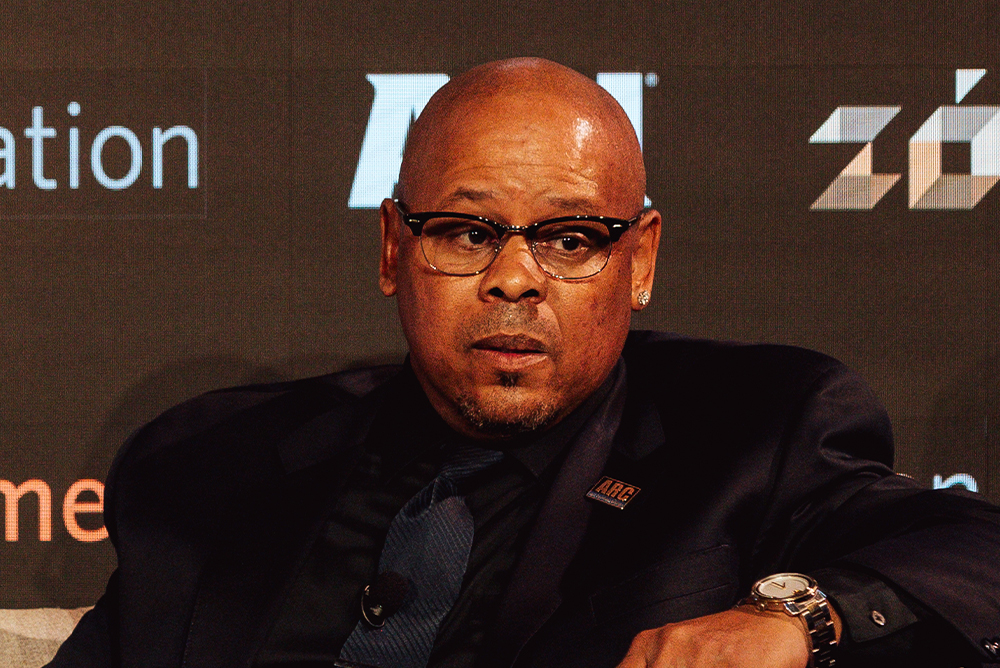
Photo by Chad Brady.
Sam Lewis is the executive director of the Anti-Recidivism Coalition. He previously served as the director of Inside Programs where he created the Hope and Redemption Team, engaging formerly incarcerated staff to lead rehabilitative programs in California prisons and prepare participants for successful reentry. Before joining the Zócalo program “What Is a Good Job Now?” For the Formerly Incarcerated—supported by The James Irvine Foundation—Lewis joined us in the green room to talk about stargazing, mentorship, and what’s on his bucket list.
What is your go-to karaoke song?
“Lean on Me,” Bill Withers. My mom would hum that song, and she was somebody that I was always able to lean on when I was incarcerated. And now, in her twilight years, I’m someone she can lean on.
What is the nerdiest thing about you?
I have a telescope, and I do look at the stars.
Where’s your favorite place to stargaze?
In prison there’s always noise. Background noise. Card games. P.A. announcements. And when you come home, you hear the city of L.A.—sirens and helicopters and traffic lights. I was visiting Lancaster and sitting on the front porch in the evening, and I couldn’t hear anything. I said, “I’m gonna move out here.” I lived in Lancaster for seven years. I could literally fall asleep in my backyard. And then I moved to Santa Clarita. The thing about those two areas is, on a clear night, the stars seem like you can just reach out and grab them.
What’s the most recent book you read?
I was just going over The Five Levels of Leadership because there’s some book reports that the youth that I mentor are doing. Whenever they’re doing a book, I always refresh it so we can talk about it.
Speaking of the young people you mentor, any generational differences you notice?
My generation, we couldn’t wait to finish our homework and our chores and go outside and play. This generation is just in front of the TV too much and playing video games and on social media. We wanted to ride our BMX bikes and Mongoose bikes. The generation I see now, they’re not like we were. Our moms would be yelling down the street, you gotta come inside. And they’re trying to get their kids to go out now and play. And they’re like, “Play? I’m on my PlayStation.”
Have you been influenced by them? Are there any video games you’ve picked up?
There’s one, but it’s not a PlayStation game. It’s a game that I play off and on. I have a 24-year-old and a 26-year-old that play a game called PUBG. I’m no good on the controller, but I’ll play that with them online. It’s like Fortnite. You play people all over the world.
What’s something on your bucket list?
There are a few things on my bucket list. I ride a Harley-Davidson, and there’s a ride where you get on the 10 freeway and you ride that all the way to the end of the freeway. My wife’s doing that in May. And I don’t want to call it my bucket list but there are a couple of places I want to travel to. I want and I will go to the west coast of Africa to see the places where they held the people who had been kidnapped before they were sent into slavery. I want to put in a locket a little bit of sand from there to wear around my neck.
What’s your favorite museum?
It would have to be EJI’s Legacy Museum. That museum captures so much of the suffering, but also the resilience of the human ability to overcome. Last year on Juneteenth, we took 25 of our young people. I’m walking with 10 of them, and maybe the first two exhibits they asked if they could step back out because it’s overwhelming.
You grew up in South Central. Where was your favorite place to go as a kid?
On Fourth Avenue, there was a YWCA. It’s where I learned to swim. I loved to swim once I learned how to.



